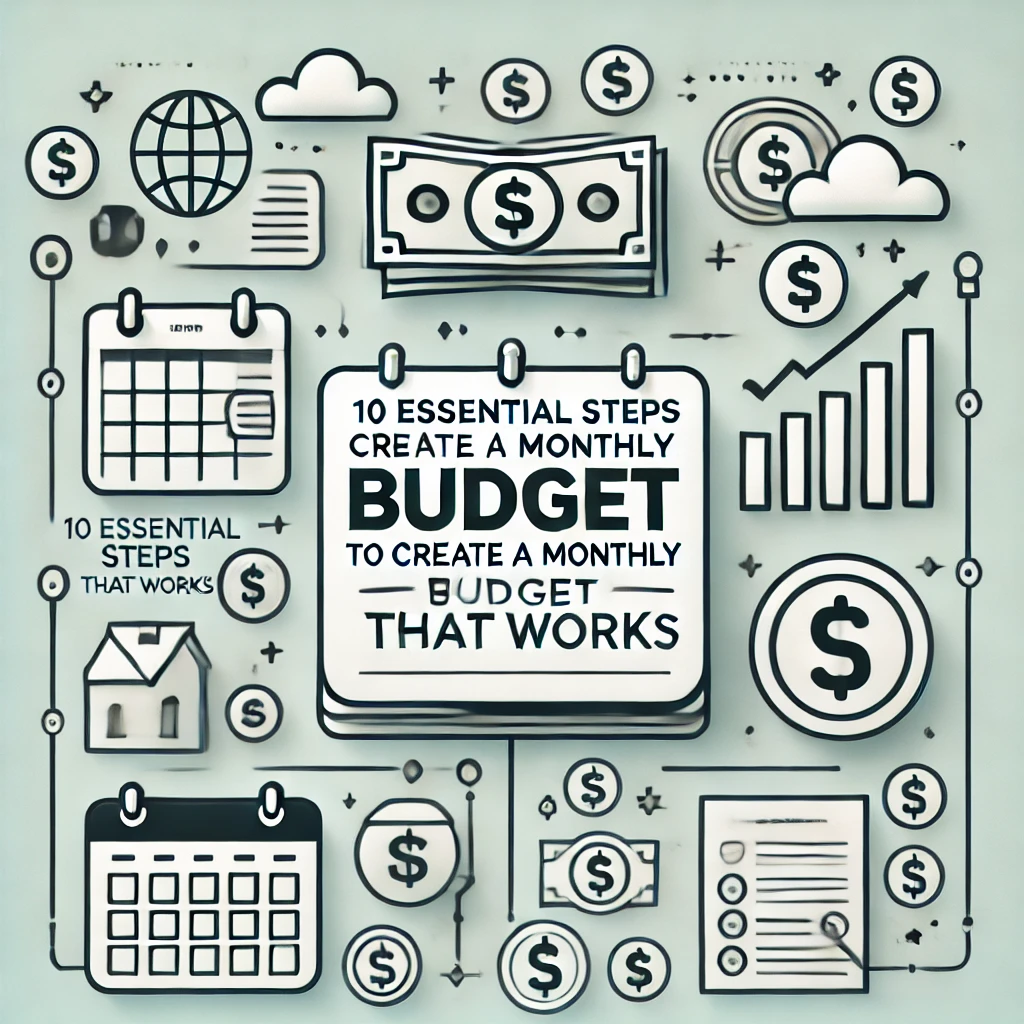10 Essential Steps to Create a Monthly Budget That Works
 Samantha Lee
Samantha LeeTable of contents
- Step 1: Set Your Financial Goals
- Step 2: Calculate Your Monthly Income
- Step 3: List Your Fixed Expenses
- Step 4: Track Your Variable Expenses
- Step 5: Add Up Your Discretionary Spending
- Step 6: Subtract Expenses from Income
- Step 7: Prioritize Debt Repayment
- Step 8: Build an Emergency Fund
- Step 9: Automate Your Savings and Payments
- Step 10: Review and Adjust Monthly

Creating a monthly budget is a vital tool for achieving financial stability. However, many individuals struggle with crafting a budget that is practical, realistic, and sustainable. Whether you're looking to save money, pay off debt, or simply gain control over your spending, a well-constructed budget is the foundation. In this article, I’ll outline ten essential steps to create a monthly budget that works for your unique situation.
As an academic consultant who has worked with clients on financial planning and management, I understand the challenges and the need for structured, effective strategies. Follow these steps to ensure your monthly budget supports your financial goals and aligns with your lifestyle.
Step 1: Set Your Financial Goals
Before diving into the numbers, the first step is to clarify your financial goals. What do you want your budget to accomplish? Are you trying to save for a down payment on a home, pay off debt, or simply break free from living paycheck to paycheck?
Clear goals will provide your budget with purpose. Without defined objectives, it’s easy to lose motivation or stray from your plan. Identify both short-term (e.g., building an emergency fund) and long-term goals (e.g., retirement savings), and make sure your budget reflects these priorities.
Example Questions:
How much do I want to save each month?
Am I looking to pay off debt aggressively, or over time?
What are my financial priorities for the next 1, 3, and 5 years?
Step 2: Calculate Your Monthly Income
The second step in creating a successful budget is knowing exactly how much money you have coming in each month. This includes your salary after taxes, but don’t forget to account for other sources of income, such as freelance work, rental income, or government benefits.
Understanding your total income is crucial because it sets the framework for all subsequent budgeting decisions. Without a clear view of your income, you run the risk of overspending or under-allocating resources to important areas like savings or debt repayment.
Step 3: List Your Fixed Expenses
Fixed expenses are those that remain the same every month. These typically include your rent or mortgage, car payments, insurance premiums, and utility bills. These are non-negotiable costs that must be factored into your budget first because they form the backbone of your financial obligations.
Make sure you list every fixed expense to avoid any surprises later on. The goal is to get an accurate picture of the costs you absolutely must cover, regardless of fluctuating variables like entertainment or dining out.
Common Fixed Expenses:
Rent or mortgage
Utilities (electricity, water, internet)
Insurance (health, car, home)
Debt payments (student loans, credit card minimum payments)
Step 4: Track Your Variable Expenses
Variable expenses fluctuate from month to month and include categories such as groceries, entertainment, transportation, and dining out. These areas are where many individuals struggle to stay within budget because the amounts can easily vary depending on habits or unplanned events.
The key to tracking variable expenses is awareness. You’ll need to look at your past spending patterns, possibly reviewing the last two or three months, to understand your average outlay. Once you’ve established a pattern, you can set realistic limits for each variable category.
Examples of Variable Expenses:
Groceries
Gas or public transportation
Dining out
Entertainment and hobbies
Clothing
Step 5: Add Up Your Discretionary Spending
Discretionary spending refers to non-essential purchases—things that enhance your lifestyle but are not necessities. These might include subscriptions, travel, gifts, or even gym memberships. It’s important to monitor this area because discretionary spending can quickly snowball if left unchecked.
Decide which discretionary purchases are important to you and which you can do without. For example, if travel is a priority, you might decide to allocate more of your budget to this category, while cutting back on dining out. Align your discretionary spending with your personal values and financial goals.
Step 6: Subtract Expenses from Income
Once you have a comprehensive list of your income, fixed expenses, variable expenses, and discretionary spending, it’s time to calculate the difference between your income and expenses. This is where the real budgeting work begins.
If your income exceeds your expenses, congratulations! You can use the surplus to increase savings, pay off debt faster, or invest for the future. However, if your expenses exceed your income, adjustments need to be made. You’ll need to either increase your income (through a side hustle, for example) or decrease your spending in non-essential categories.
Questions to Consider:
Are there areas where I’m overspending?
How can I reallocate funds to better align with my goals?
Can I cut back on certain discretionary expenses?
Step 7: Prioritize Debt Repayment
If you have debt, making it a priority in your budget can help you achieve financial freedom faster. Whether it’s student loans, credit card debt, or a mortgage, allocating a specific amount toward debt repayment each month is essential.
There are different strategies for paying off debt:
Debt Snowball: Pay off smaller debts first to build momentum.
Debt Avalanche: Focus on paying off high-interest debts first to minimize long-term costs.
Whichever method you choose, make sure your budget includes enough room to cover at least the minimum payments on all your debts while still prioritizing other financial goals.
Step 8: Build an Emergency Fund
An emergency fund is a financial safety net that helps you navigate unexpected expenses, such as medical bills, car repairs, or job loss. A general rule of thumb is to aim for three to six months' worth of living expenses in your emergency fund, though this can vary depending on your personal situation.
Start by setting aside a small portion of your income each month, and gradually increase the amount as you’re able. If you don’t have an emergency fund yet, make this a priority in your budget planning to avoid future financial stress.
Step 9: Automate Your Savings and Payments
One of the easiest ways to ensure that you stick to your budget is to automate your savings and bill payments. By setting up automatic transfers to a savings account or automating your debt payments, you remove the temptation to spend money earmarked for other purposes.
Automation also saves time and helps prevent missed payments, which can result in late fees or damage to your credit score. Most banks and financial institutions offer free tools for automating payments, making it an easy addition to your budgeting strategy.
Step 10: Review and Adjust Monthly
A budget is not a static document. It’s essential to review and adjust your budget on a monthly basis to account for changes in your financial situation. This might include an increase in income, new expenses, or evolving financial goals.
At the end of each month, take a moment to reflect on your spending and savings habits. Did you stick to your budget? Were there any unexpected costs? Are your financial goals still on track? By reviewing and adjusting your budget regularly, you’ll ensure that it continues to work for you as your needs change.
Subscribe to my newsletter
Read articles from Samantha Lee directly inside your inbox. Subscribe to the newsletter, and don't miss out.
Written by

Samantha Lee
Samantha Lee
Samantha Lee is a seasoned professional in document design and workflow optimization with over a decade of experience in enhancing office productivity. Holding a degree in Business Administration from the University of Michigan, she has honed her expertise in streamlining processes through innovative document management solutions. Samantha has worked with a variety of corporations, helping them implement effective templates and automated processes that save time and reduce errors.